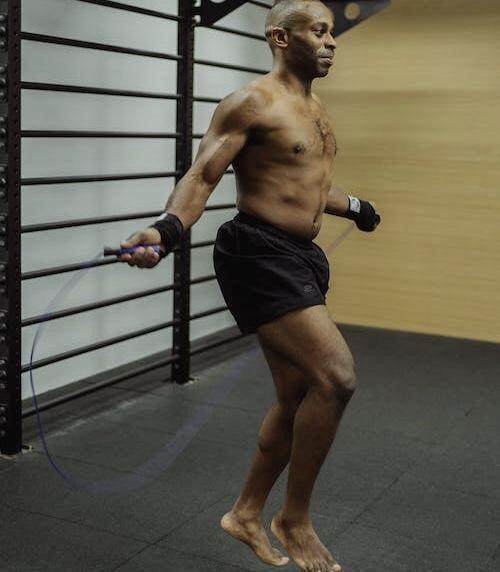Touwspringen is een bekende cardio- en krachttraining voor het hele lichaam die deel uitmaakt van bijna elke atleet zijn routine. Maar het is niet alleen voor atleten, want fitte personen kunnen er ook aan deelnemen. Echter, als het gaat om zware springtouwtraining, moet de persoon een bepaalde mate van uithoudingsvermogen hebben omdat het uitdagender is. De reden hiervoor is dat zonder oefening, zware springtouw oefeningen en technieken niet geschikt zijn voor sommige personen.
Je kunt dus niet zomaar een zwaar springtouw oppakken en deelnemen aan touwgevechten of andere oefeningen. Als je dat doet, duw je jezelf te hard en zal je lichaam de gevolgen voelen. Tempo is belangrijk bij oefeningen zodat je geleidelijk kunt vooruitgaan. Daarom zijn er bepaalde dingen die je moet leren over zware springtouwtraining voordat je het probeert. Als je geïnteresseerd bent in de feiten, lees dan verder.
Belangrijkste punt
Touwspringen is een kindersport die doorgaat tot in de volwassenheid vanwege het gemak en de voordelen als een volledige lichaamstraining. Er spelen echter bepaalde factoren mee als je wilt touwspringen, waarvan de keuze van het springtouw een van de belangrijkste is. De meeste mensen vinden het moeilijk om te kiezen tussen speed ropes en verzwaarde touwen. Maar basiskennis maakt de beslissing makkelijker, aangezien zware springtouwtraining niet voor beginners is.
Je hebt ervaring en uithoudingsvermogen nodig om de uitdagingen van een verzwaard springtouw aan te kunnen. Maar als je al professioneel bent in touwspringen, zou dit touw geen probleem voor je moeten zijn.
Feiten over zwaar springtouwtraining

Bron: Pexels
Er zijn twee hoofdtypen touwen om mee te springen; speedtouwen en gewichtstouwen of zware touwen. Mensen zijn echter meer vertrouwd met speedtouwen omdat ze lichtgewicht en gemakkelijk te gebruiken zijn. Gewichtstouwen zijn echter sterker, steviger en uitdagender. Daarom vragen mensen zich af of training met zware touwen veilig en goed is. Laten we de kenmerken van beide touwsoorten vergelijken en feiten over de gewichtstouwen bekijken om het antwoord te leren.
| Speedtouwen | Zware touwen |
| Ze zijn lichtgewicht. | Hun koorden zijn zwaarder. |
| Het is snel en gemakkelijk te gebruiken. | Het verzet zich tegen beweging en is moeilijker te gebruiken. |
| Deze hebben rubberen/plastic handvatten. | Ze hebben gewichtshandvatten. |
| Verbrandt snel calorieën. | Het helpt bij het opbouwen van meer spieren. |
| Bevordert behendige bewegingen en oefeningen. | Bevordert uithoudingsoefeningen. |
Het biedt variatie
Training met lichte speedtouwen beperkt het bewegingsbereik en de voordelen op het gebied van touwtjespringen. Daarentegen is trainen met een gewichtstouw uitdagender en biedt het een verscheidenheid aan oefeningen. Terwijl speedtouwen alleen traditionele touwtjespringactiviteiten vergemakkelijken, zijn zware touwen goed voor:
- Alle traditionele touwtjespringroutines.
- Variaties van de basis touwtjespringworkout.
- Touwgevechtsoefeningen.
- Push-ups, en nog veel meer.
Sneller in het verbranden van calorieën
Een gewichtssprong is effectiever bij het starten met touwtjespringtraining voor gewichtsverlies. De reden is dat gewichtstouwen helpen om sneller calorieën te verbranden dan speedtouwen.
Kracht opbouwen
Vanwege de dikte en het gewicht van de touwen verbruik je meer energie om ermee te werken. Je schouders, armen en rug dragen het grootste deel van het werk, bouwen meer spieren op en krijgen kracht en uithoudingsvermogen. Dus, zwaar springtouw versterkt de bovenlichaamsspieren.
Het is een Anaerobe en Aerobe Oefening
Zware springtouwtraining is aeroob en anaeroob, het versterken van het hart en het vormen van de spieren. Als een low-impact HIIT-oefening verbetert het de stofwisseling en levert het energie en uithoudingsvermogen. Vanwege zijn aard biedt het talrijke voordelen.
Samenvattend hangt de veiligheid van zware springtouwtraining af van het vaardigheidsniveau van de persoon. Vanwege de complexiteit van de oefening is het onveilig voor beginners. Een beginner die hieraan deelneemt kan spierverrekking oplopen. Daarom zijn weighted springtouwtrainingstechnieken goed en aan te raden voor atleten, zoals je enkele voordelen hebt gezien.
Tips om je te helpen zware springtouwtraining te beheersen
Hieronder staan enkele tips om je te helpen bij je spieropbouwende weighted springtouwtraining.
- Wanneer je het touw vasthoudt, moet je duim naar binnen wijzen. Dit vermindert de belasting van je pols.
- Pak een springtouw met een geschikte maat.
- Spring hoger nadat je het touw hebt gezwaaid omdat de beweging langzaam is.
- Besteed aandacht aan elke beweging, zodat je armen synchroon kunnen zwaaien en je benen tegelijkertijd kunnen optillen. Door dit te doen, zal je coördinatie verbeteren.
- Bewegingen zijn ritmisch, dus het volgen van je ritme helpt je aan te passen aan zware springtouwtraining
- Beheers de basis zware springtouwoefeningen voordat je doorgaat naar gevorderde.
Conclusie
Zware springtouwtraining is fantastisch en biedt veel voordelen voor de deelnemers. Het is echter niet voor iedereen, omdat het tact, vaardigheid en ervaring vereist om uit te voeren. Beginners moeten het daarom vermijden.
Maar voor degenen die zware touwen kunnen hanteren, is deze oefening veilig. Het is ook voordelig, met als een van de belangrijkste voordelen spieropbouw. Daarom moet je pas deelnemen aan zware springtouwtraining nadat je een bepaald niveau van bekwaamheid en beheersing van het spel hebt bereikt.
Hey daar atleet; ik geloof dat je klaar bent om je schoenen te strikken en aan een zware springtouwtraining te beginnen. Als dat zo is, geef ons dan feedback over hoezeer onze hulpmiddelen je hebben geholpen. Als dat niet zo is, werk dan aan het beheersen van de basisvaardigheden met het speed rope en probeer het opnieuw met meer geluk!














